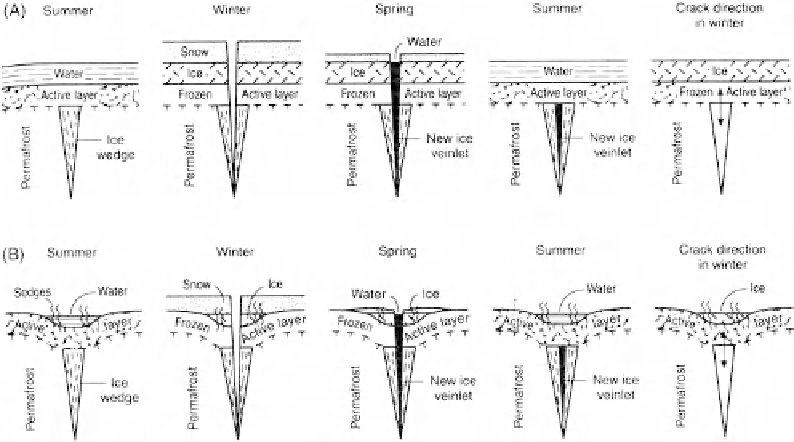Geology Reference
In-Depth Information
Figure 6.6.
Diagram illustrating the growth of ice wedges beneath shallow pool of standing water
(A) and beneath a water-fi lled ice-wedge trough (B). Crack initiation must commence at the top of
permafrost and propagate upwards and downwards. Neither the pool of water above the ice wedge
(case A) nor the semi-liquid active layer (case B) can memorize the location of the previous
year's crack. From Mackay (1989b). Reproduced by permission of the Canadian Association of
Geographers.
cracking (Table 6.1). Cold air temperatures are the primary requirement; these are usually
between
−
25 °C and
−
40 °C with ground surface temperatures ranging from
−
15 °C to
−
25 °C. Given that cracking originates from the top of permafrost, attention must also
focus upon cooling rates at both ground surface and top of permafrost. In all three fi eld
studies, the TTOP temperature at the time of cracking was between
−
10 °C and
−
20 °C
and the ground cooling rate ranged between
0.6 °C/day.
Much still remains unclear about the mechanism of thermal-contraction cracking. For
example, the early stages of permafrost aggradation at Illisarvik were characterized by
unusually large (wide) thermal-contraction cracks (Mackay, 1986d), the cause of which is
unclear. Second, the development of the polygonal net is not fully understood; lateral pro-
pagation is often short, unconnected, and frequently offset, and few cracks extend horizon-
tally for more then 5 m. Finally, the infl uence which polygon topography exerts upon snow
distribution, ground temperatures, and the cracking process needs further clarifi cation.
+
0.1 °C and
−
6.2.6. Climatic Signifi cance
Thermal-contraction-crack polygons are landforms of climatic and paleoclimatic signifi -
cance. This is because (a) cracking requires permafrost and (b) cracking occurs when air
temperatures drop well below 0 °C. Based upon the distribution of active cracking in
Alaska and elsewhere, T. L. Péwé (1966b) concluded that thermal-contraction cracking
occurs where the mean annual air temperature (MAAT) is
6 °C or colder. This simple
threshold value must be treated with extreme caution because it is now clear that cracking
is largely controlled by ground temperature (TTOP), the ground-thermal gradient, and
snow cover.
−

